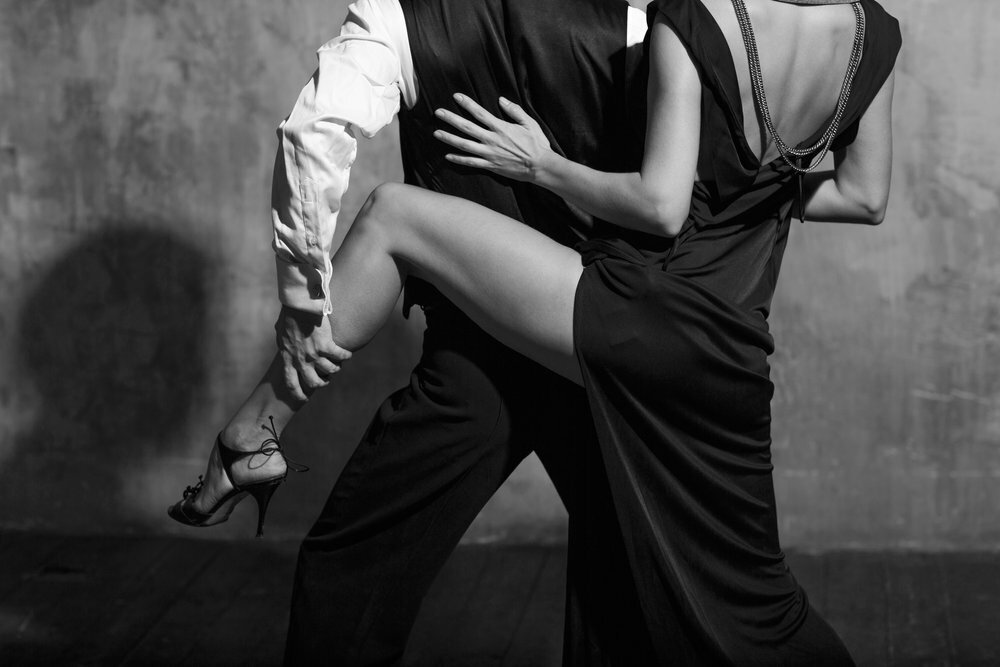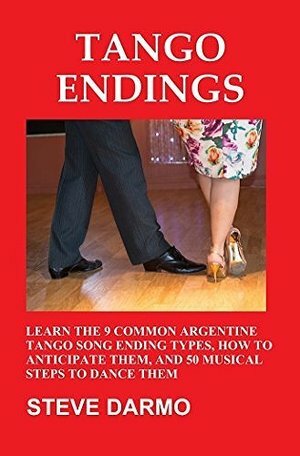With Steve Darmo’s Tango Endings, of course!
For those who are unfamiliar, Tango Endings is a book by Steve Darmo, a tango dancer from Toledo who is, quite uniquely, the instructor of a subject matter rarely — if at all — discussed in Argentine tango classes: the ending.
Beginners and experienced dancers alike would surely notice that most material involving tango dancing tends to be more focused on certain aspects of the dance, such as improvisation, figures, and steps.
A quick search for tango on the internet would lead to numerous videos providing valuable advice on technique and execution. There’s also no lack of information about the history of tango, as well as biographies on tango luminaries, their achievements, and contributions to the dance.
Has one ever encountered structured and well-researched material specifically about the tango ending? Will a tango ending make any difference at all?

The Importance of Last and Lasting Impressions
Steve Darmo certainly thinks that knowing how to end a tango dance is a crucial aspect of enriching one’s tango dancing experience. He aptly explains this philosophy in a post from his blog, The International Tango Machine:
“Ending the dance properly is one of the most important things when dancing Argentine tango. Some might say it is THE most important part, along with starting the dance well.
A good strong start to the dance will certainly make a good first impression. However, no matter how the rest of the dance went, your partner will be left with a lasting impression of how it ended.
“This is just like a gymnast who sticks the ending at the end of the routine. Even if the routine was full of errors, the gymnast will feel better and always get an applause from the crowd if there is a good landing at the end.
An ending well timed and executed will please your dance partner. It can salvage an otherwise lousy dance or put an exclamation mark at the end of a remarkable dance.
A poor ending will also leave a bad impression and could ruin the good feeling from a dance that was otherwise fantastic.”
This same principle about leaving a lasting impression can also be applied to many aspects of one’s life — not just in tango. In fact, people tend to recall only first impressions and last impressions about another person, such as a dance partner. While one has been convinced to think that first impressions are the most important, it may actually be the case that what one leaves as a last impression is more crucial overall.
A post from Your Dost argues:
“We have always been told to create a great first impression. However, what is equally or more important is the last impression you create.”
“For, the last impression is the lasting impression, something that stays with the other person for a long time.”
“That is the reason the best is always left for the last. That is why every stage show ends with a grand finale. The last impression is what people take home. Making a good first impression is an important component of any job interview or personal interaction. But equally significant is your last impression.”
“In psychological terms, the tendency to remember first and last impressions are called the primacy or recency effect. In short, our brains tend to remember the first item (primacy) and last item (recency) in a series.”
Aside from job interviews, relationships are perhaps one of the most significant life phases where the last impression is vital.
In many respects, tango can be considered a relationship as it necessitates communication, respect, and trust, among others.
A post from LinkedIn by entrepreneur and investor Mika Salmi provides an example of how last impressions can affect even one’s recollection of a relationship:
“[A] last impression is something that sticks with people. Think about the break up of a relationship and all that went down with that process. You might remember that romantic trip to the beach but clouding that will be how the other person acted as the relationship unraveled. You may even remember some choice parting words or a thrown object. Ouch!”
Similarly, in tango, one’s dance partner may remember a tanda fondly, but how it ends will always punctuate their experience.
The ending, whether good or bad, will be inevitably tied to the memory of the person one has danced with.
Depending on the experience, one can decide whether it would be a good idea to share another tanda with the same person, find another partner, or even leave a milonga altogether.
Steve Darmo’s Journey and Discoveries
Now that the importance of ending a tango dance properly has been established, what led Steve Darmo to take it upon himself to conduct in-depth research about tango endings, as well as provide classes to dancers who may not be aware of the significance of this part of the dance?
Much of his reasons and the process he used to explore this concept are discussed in his highly-acclaimed book, Tango Endings: Learn the 9 Common Argentine Tango Song Ending Types, How to Anticipate Them, and 50 Musical Steps to Dance Them.
To date, Tango Endings remains as the only published source material that focuses on the concept of tango endings.
If you want to hear Steve’s explanations and see examples of the endings as he demonstrates with his partner check out this on-demand WORKSHOP.
An excerpt from the book’s preview in Amazon gives one a background of why Steve Darmo set out on his journey:
“Every now and then, someone tells me that there was once a class on endings, years ago, or they heard about one, thousands of miles away. These rumours of such classes tell me they must exist. But I have yet to personally find an instructor or class that has been devoted to teaching how to improve the endings of your dance. [...]
“I have seen no classes on this in my area, despite being able to find a class, practica, or milonga within an hour or two of my home every night of the week. The instructors travelling through the area, who include some of the best in the United States and from all over the world, apparently haven’t put together a workshop on endings. [...]
“Why should great endings be [in] the realm of the masters only? Why do they leave us mere tango peasants to fend for ourselves? Are there any shortcuts?
“I set out to find the secret.”
For three years, Steve Darmo conducted his research on tango endings, first focusing on the steps and movements. However, he eventually realized that focusing on musicality instead of steps would lead to more fruitful discoveries. In compiling his knowledge, he took himself to task and listened to 1,700 tango songs from some of the most well-known tango orchestras of the dance’s Golden Age. These included music from revered tango maestros such as Anibal Troilo, Osvaldo Pugliese, Juan D’Arienzo, and many others.
As Steve Darmo explored the wide range of musicality that tango has, he was able to discover how important it is to be knowledgeable about tango orchestras to identify when a song will end, thus allowing dancers to properly time the conclusion to a song.
During his research, he classified nine common tango endings and three other uncommon endings. One can find a list of these endings along with accompanying tango music in his website Tango Endings, which also serves as supplementary material for his book. The typical tango endings by orchestra are as follows:
Tango Endings: Learn the 9 Common Argentine Tango Song Ending Types, How to Anticipate Them, and 50 Musical Steps to Dance Them Kindle Edition
Classic Type I Endings
Classic Type II Endings
Classic Type III Endings
Classic Type IV Endings
Dramatic Stressed Endings (Suspended Endings)
Early Endings (Short Endings/Missing Note Endings)
Late Endings (Delayed Endings/Early and Late Endings)
Long Slow Drawn-Out Endings
Long Drawn-Out Slow Endings with Extra Late Notes
The three endings below are the more uncommon types:
Oddball Endings
Surprise Endings
Fake Endings
Steve Darmo’s Tips and Clues in Identifying Tango Endings
In Chapter 2 of his book, Steve Darmo recognizes the challenge of knowing when a song will actually end, himself admitting that he doesn’t count during a dance despite being an engineer. Like him, he acknowledges that not everyone who dances tango is musically-inclined, which may pose a bit of a struggle if one wants to correctly identify tango endings to properly time how they may conclude the dance. Fortunately, the book offers tips and clues on how this can be accomplished:
“The music will give signals, often very subtle, as to when and how it will end. [...] Generally, in the last phrase or two of the song, the orchestra will throw in something special and different from what has been played so far. This can act as a sign that the music will be ending. “
“Here are some general clues to listen for:
“More intensity in the music with more instruments playing in a flurry of sound (the variación).
Some solo instrumentation accentuating a few notes that will catch your attention.
An extra-long pause or break.
Some orchestras will slow things down going into the last phrase or two.”
Aside from general tips, Tango Endings also discusses another step in recognizing the end of a song. In this second step, Steve Darmo emphasizes on the importance of being able to distinguish the cadence of a song.
He defines the cadence as a “sequence of notes or chords that indicates the momentary or complete end of a composition, section or phrase.”
He also cites two important things that dancers may find helpful in identifying the cadence:
● “The cadence of the last phrase of the song is almost always going to be different from the cadence of the other phrases of the song. It will either be a different cadence completely, or it may be similar but with a different articulation.
● “There are a very limited number of distinct cadences that the vast majority of tango songs will use on the final phrase to end the song. If you can recognize one of these cadences at the end of a phrase late in the music, then chances are that the song is about to immediately end.”
Of course, these are just introductory notes on Steve Darmo’s process, and anyone who wants to learn about dancing tango and the significance of musicality will be well served by reading Tango Endings in full. There are many other chapters in the book that take a deep dive into a concept that is often overlooked despite its significance in the overall tango dancing experience. To fully immerse oneself in the book and its insights, it is highly recommended to read while checking out Steve Darmo’s website, which links videos to the songs being referenced in the book.

Endings and Beginnings
Tango is full of beginnings and endings. The dance, like the song, will come to an eventual conclusion. As much as it’s important to start the dance on a good note, equally crucial is being able to end it at the right time and leave a good lasting impression.
Steve Darmo’s Tango Endings is a great way to begin learning about how to properly predict and act when a tango song is about to end. With his knowledge, insights, and supplementary information, one can enrich one’s tango experience, as well as their partner’s.
If you wish to learn Argentine Tango, we put our methodology in the book. You can reserve yours HERE.



